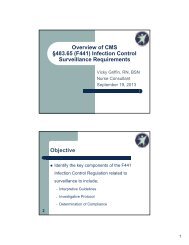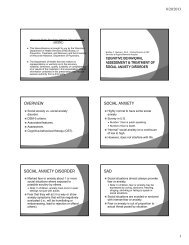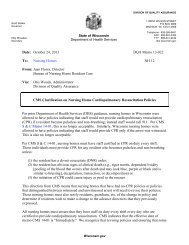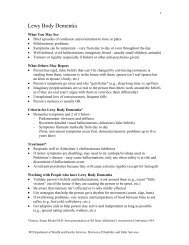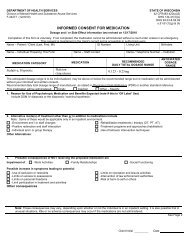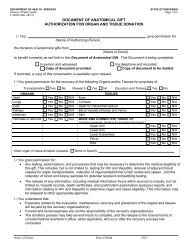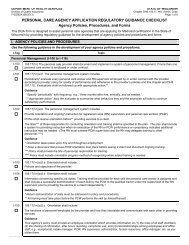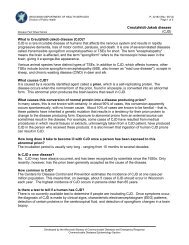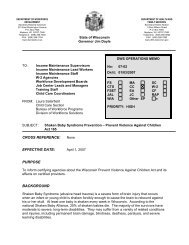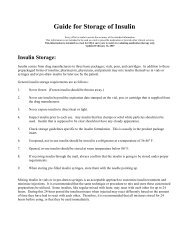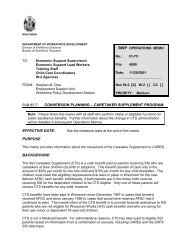Pedometer Walking Program - Wisconsin Department of Health ...
Pedometer Walking Program - Wisconsin Department of Health ...
Pedometer Walking Program - Wisconsin Department of Health ...
Create successful ePaper yourself
Turn your PDF publications into a flip-book with our unique Google optimized e-Paper software.
DEPARTMENT OF HEALTH SERVICES STATE OF WISCONSIN<br />
Division <strong>of</strong> Public <strong>Health</strong><br />
F-40075 (11/04)<br />
Using a pedometer to measure the number <strong>of</strong> steps you take in a day is a good way to start a physical activity program<br />
and a good way to track your progress. On average, a moderately active person will walk 5,000 to 7,000 steps in a<br />
day, which is the equivalent <strong>of</strong> about 3 miles <strong>of</strong> walking (2,000 to 2,500 steps equals about 1 mile.). The goal you<br />
choose at 4-weeks, 6-weeks, 8-weeks or longer is up to you and will depend on your starting point and lifestyle. If you<br />
are 35 year <strong>of</strong> age or older or have any health concerns about starting or increasing your physical activity level, talk to<br />
your doctor before beginning a new physical activity program.<br />
Week 1 Baseline: Record your steps daily. At the end <strong>of</strong> the week, add up your steps for the 7 days and<br />
divide by 7 to get a daily step average or baseline.<br />
Steps Today<br />
Monday Tuesday Wednesday Thursday Friday Saturday Sunday<br />
Total Steps for Week 1 _________ ÷ 7 = _________ Daily Step Average/Baseline<br />
Would you like to set a Goal? Now that you know your baseline number <strong>of</strong> steps, do you want to set a step goal<br />
for some point in the future? If yes, pick a date in the future and right in your daily step goal here.<br />
Goal: _________ steps per day by __________ (date).<br />
To build up your steps and endurance, you should gradually increase the number <strong>of</strong> steps you walk each week. How<br />
much you increase is up to you, but this walking program suggests that you increase your walking by 500 steps per<br />
day. For example, someone who has a baseline number <strong>of</strong> 2,000 steps should try to walk 2,500 steps per day in Week<br />
2. Using this method to project your goal for Week 3 and beyond, you would add 500 to 2,500 (Week 2) and 3,000<br />
steps per day is your goal in Week 3 (2,500 + 500), 3,500 in Week 4 (3,000 + 500) and 4,000 in Week 5 (3,500 +<br />
500). Using this progression, this person could double their distance in 5 weeks.<br />
You can use a smaller target for the number <strong>of</strong> steps you add each week. For example, increase the daily total at the<br />
end <strong>of</strong> a week by 300 steps instead <strong>of</strong> 500 steps or stay at a goal for more than one week if you think the progression is<br />
too rapid for you. You could also increase the added steps (ex: 500 to 700) if you want to progress more quickly. It’s<br />
solely up to you and you should progress at a pace that’s comfortable for you until you reach your goal.<br />
Week 2: Gradual increase (500). Add 500 to your daily step average/baseline from Week 1 to use as your<br />
Week 2 target. (Tip: During the day take short stretching and walk breaks.)<br />
Monday Tuesday Wednesday Thursday Friday Saturday Sunday<br />
Steps Today<br />
Week 2 Target: ______ Total steps for Week 2 _______ ÷ 7 = _______ Average steps for Week 2.<br />
Week 3: Gradual increase (500). Add 500 to your daily step average from Week 2 to use as your Week 3 target.<br />
(Tip: Look for easy ways to increase your steps like taking the stairs, parking farther away, etc.)<br />
Steps Today<br />
PEDOMETER WALKING PROGRAM<br />
Monday Tuesday Wednesday Thursday Friday Saturday Sunday<br />
Week 3 Target: ______ Total steps for Week 3 _______ ÷ 7 = _______ Average steps for Week 3.
F-40075 (11/04) Page 2 <strong>of</strong> 2<br />
Week 4: Gradual increase (500). Add 500 to your daily step average from Week 3 to use as a Week 4 target.<br />
(Tip: You are going to have to work harder now to increase your steps. If you haven’t done so<br />
already, recruit a walking partner or group. <strong>Walking</strong> with others will help motivate you on days you<br />
are busy or don’t feel like walking.)<br />
Steps Today<br />
Monday Tuesday Wednesday Thursday Friday Saturday Sunday<br />
Week 4 Target: ______ Total steps for Week 4 _______ ÷ 7 = _______ Average steps for Week 4.<br />
Week 5: Gradual increase (500). Add 500 to your daily step average from Week 4 to use as a Week 5 target.<br />
(Tip: Make short walking trips instead <strong>of</strong> taking the car. Walk for 15-45 minutes during your lunch<br />
period.)<br />
Steps Today<br />
Monday Tuesday Wednesday Thursday Friday Saturday Sunday<br />
Week 5 Target: ______ Total steps for Week 5 _______ ÷ 7 = _______ Average steps for Week 5<br />
Continue your program until you reach your goal. You may want to modify your goal during this program or reset<br />
your goal once you reach it. There are a number <strong>of</strong> programs that use 10,000 steps per day as a fitness goal. This may<br />
not work for all individuals. The recommended minimum level <strong>of</strong> moderate physical activity is at least 30 minutes <strong>of</strong><br />
activity, at least 5 times per week. In a pedometer program, 4,000 to 5,000 steps translates into 30 minutes <strong>of</strong> activity.<br />
Higher step levels will increase fitness and will also help with weight loss or weight maintenance.<br />
Just about any pedometer will serve as a basic way to track steps. However, if you’re looking for a more accurate<br />
measurement or want additional features such as distance, calorie expenditure, etc. then you may want a more<br />
sophisticated pedometer. For more information on choosing a pedometer for its accuracy and list <strong>of</strong> features, visit the<br />
following Website http://walking.about.com/cs/measure/tp/pedometer.htm.<br />
If at some point you become bored with this walking program, there are several walking programs that have a variety<br />
<strong>of</strong> ideas to spice up your walking schedule. Additional ideas can be found at:<br />
http://walking.about.com/cs/measure/tp/pedometerprog.htm.<br />
If you want to expand and track your physical activity program beyond walking, check out the physical activity log at<br />
http://dhs.wisconsin.gov/forms/F4/F40073.pdf .
DEPARTMENT OF HEALTH AND FAMILY SERVICES STATE OF WISCONSIN<br />
Division <strong>of</strong> Public <strong>Health</strong><br />
DPH 40073 (12/05)<br />
MONTHLY PHYSICAL ACTIVITY SHEET<br />
Month ___________<br />
1 Point/4 min<br />
Bicycling >16 mph<br />
Handball, Squash,<br />
Racquetball<br />
Rowing-vigorous<br />
Running > 7 mph<br />
X-C skiing – racing<br />
1 Point/5 min<br />
Boxing/sparring<br />
Football<br />
Martial arts<br />
Rope jumping<br />
Running, 6 mph<br />
Soccer -vigorous<br />
Swimming - vigorous<br />
X-C skiing – vigorous<br />
1 Point/6 min<br />
Basketball – game<br />
Bicycling 12-15 mph<br />
Bicycling stationary<br />
Calisthenics-vigorous<br />
Carrying heavy loads<br />
Circuit training<br />
Hockey<br />
Rock climbing<br />
Running, 5 mph<br />
X-C skiing–moderate<br />
Snow shoeing<br />
Swimming–moderate<br />
Tennis, singles<br />
Volleyball, beach<br />
<strong>Walking</strong> upstairs<br />
1 Point/10 min<br />
Aerobic – general<br />
Backpacking/hiking<br />
Bicycling 10-12 mph<br />
Canoeing - moderate<br />
Dancing – aerobic, fast<br />
Jet-skiing, water<br />
Jogging < 5 mph<br />
Moving boxes<br />
Rowing – moderate<br />
Shoveling snow<br />
Skating – vigorous<br />
Skiing-moderate<br />
Sledding<br />
Soccer – moderate<br />
Swimming-leisure<br />
Tennis – doubles<br />
Weight lifting-vigorous<br />
<strong>Walking</strong> – brisk, 4 mph<br />
Name _______________________________________________<br />
Date<br />
1<br />
2<br />
3<br />
4<br />
5<br />
6<br />
7<br />
8<br />
9<br />
10<br />
11<br />
12<br />
13<br />
14<br />
15<br />
16<br />
17<br />
18<br />
19<br />
20<br />
21<br />
22<br />
23<br />
24<br />
25<br />
26<br />
27<br />
28<br />
29<br />
30<br />
31<br />
Activity<br />
Approximate calories burned during activity<br />
1 point = 40 calories for a 105 pound person<br />
1 point = 50 calories for a 130 pound person<br />
1 point = 60 calories for a 155 pound person<br />
1 point = 70 calories for a 180 pound person<br />
1 point = 80 calories for a 210 pound person<br />
1 point = 90 calories for a 235 pound person<br />
1 point = 100 calories for a 260 pound person<br />
Resting Metabolic Rate = about 1 to 2 points/hr<br />
Length<br />
<strong>of</strong> Time<br />
Points<br />
Total Points<br />
Sub-total<br />
Multiply by calories/point (see weight chart) x ______<br />
Total calories burned this month<br />
Point Goal ______<br />
1 Point/12 min<br />
Badminton<br />
Basketball – shooting<br />
Construction/remodel<br />
Dancing<br />
Golf – without cart<br />
<strong>Health</strong> Club – general<br />
Housework – vigorous<br />
Hunting<br />
Kayaking<br />
Mowing lawn –walking<br />
Play w/kids – vigorous<br />
Skate/Roller blade<br />
S<strong>of</strong>tball or Baseball<br />
Volleyball – vigorous<br />
Yard work, raking etc.<br />
1 Point/15 min<br />
Archery<br />
Auto Repair<br />
Bicycling



